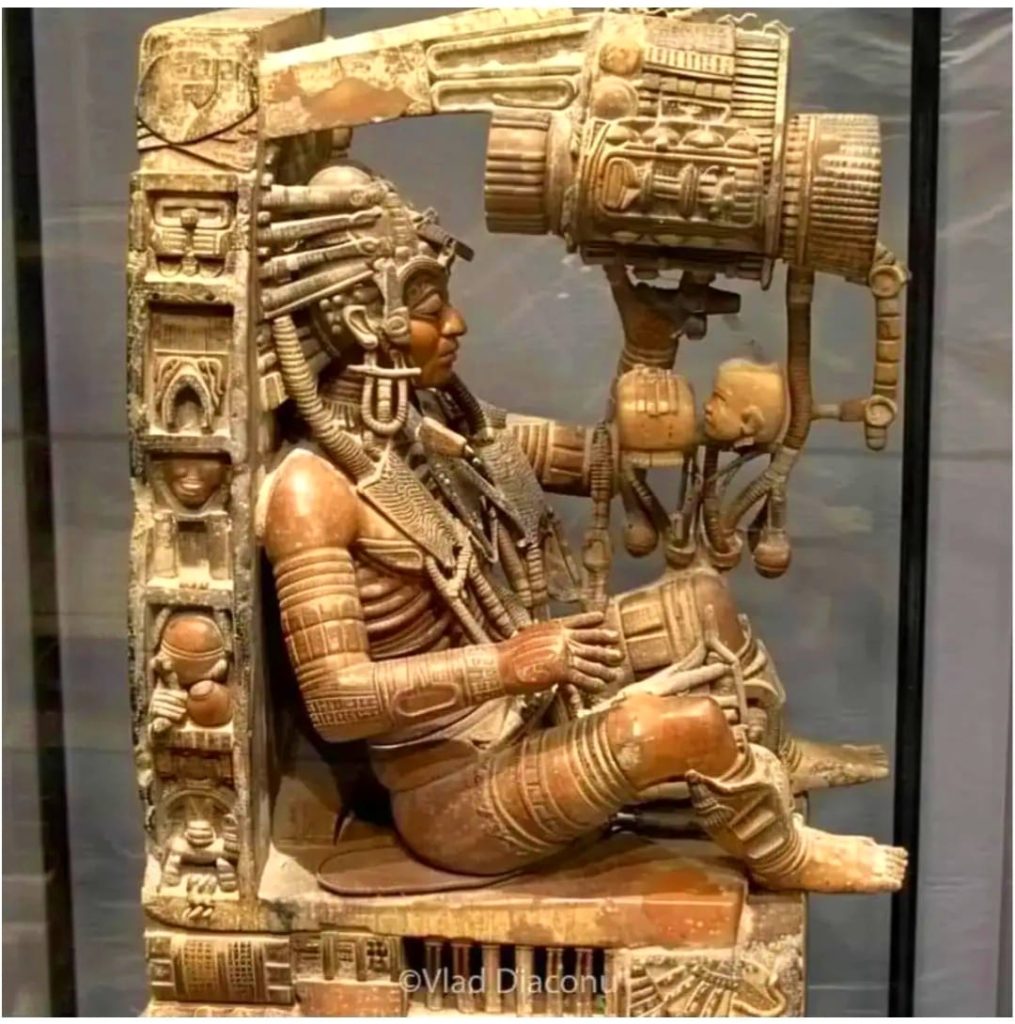Deep in the heart of the ancient Maya world lies one of archaeology’s most enigmatic and captivating discoveries—the sarcophagus lid of K’inich Janaab’ Pakal, commonly known as Pakal the Great. Unearthed in the ancient city of Palenque, located in present-day Chiapas, Mexico, this 7th-century artifact has ignited a firestorm of debate, curiosity, and wonder ever since its discovery. Revered for both its intricate artistry and its symbolic depth, this masterpiece has inspired countless interpretations. Among these, one of the most famous—and controversial—is the theory that it depicts an ancient astronaut, a belief that has led many to nickname it “The Palenque Astronaut.”

Upon first glance, the carvings on the lid reveal a remarkably complex scene. The central figure, identified as Pakal himself, appears reclined within an elaborate structure that some have likened to the cockpit of a spacecraft. His limbs are bent in a posture that has been compared to that of an astronaut maneuvering controls, while surrounding motifs seem to resemble tubes, gears, and mechanical devices. This visual impression captured the imagination of many, especially after Swiss author Erich von Däniken popularized it in his 1968 best-selling book Chariots of the Gods?. Von Däniken proposed that ancient civilizations had contact with extraterrestrial beings, using Pakal’s sarcophagus lid as a central piece of evidence for his theory. His depiction of Pakal as an “ancient astronaut” fueled a global fascination with the idea that extraterrestrial visitors influenced the Maya and other early cultures.
However, archaeologists and scholars steeped in Mesoamerican history and symbolism present a very different—and widely accepted—interpretation of the sarcophagus lid’s imagery. They argue that the carvings are not evidence of space travel, but rather a profound representation of Mayan cosmology, religious belief, and royal power. According to these experts, the scene portrays Pakal’s sacred passage into the underworld, known to the Maya as Xibalba. Far from a rocket ship, the elaborate framework around Pakal is a symbolic depiction of the World Tree—also called the Ceiba tree—a central motif in Maya spiritual life. This sacred tree connects the three realms of existence: the heavens above, the earthly plane, and the underworld below.
In this context, Pakal is shown in the midst of his transformation from mortal king to divine ancestor. His pose, far from being that of an astronaut, reflects traditional postures associated with death and rebirth in Mayan funerary art. Above him, the branches of the World Tree stretch toward the heavens, while its roots extend into the underworld, symbolizing Pakal’s journey from the physical world into the spiritual realm. The scene is one of transition, cosmic balance, and eternal legacy.
Adding another layer of significance, the lid is rich in celestial symbolism. The Maya were extraordinary astronomers, capable of tracking celestial events with remarkable precision. Their understanding of the movements of the sun, moon, planets, and stars informed not only their calendars but also their religious ceremonies and royal rituals. The glyphs and symbols carved into Pakal’s sarcophagus lid align with this astronomical knowledge, situating Pakal within the grand cosmic order. His alignment with celestial forces emphasized his role as a divinely sanctioned ruler whose life and death mirrored the movements of the cosmos.
Despite the scholarly consensus regarding the true meaning of the sarcophagus lid, the “Palenque Astronaut” theory continues to resonate with many people. It speaks to a universal human fascination with the mysteries of the past and our yearning to connect with something beyond the earthly realm. The idea that ancient peoples might have had contact with beings from other worlds captures the imagination and offers a tantalizing, if speculative, vision of history.
Regardless of which interpretation one favors, the sarcophagus lid of Pakal the Great stands as a powerful testament to the artistic, intellectual, and spiritual achievements of the Maya civilization. Its finely detailed carvings reflect not only exceptional craftsmanship but also a deep philosophical understanding of life, death, and the universe. The lid is a visual narrative that invites us to explore the complex worldview of the Maya, one in which kings were not just rulers but intermediaries between the divine and mortal realms.
Today, this artifact continues to be studied, admired, and debated. It challenges us to consider how ancient peoples understood their place in the cosmos and how they sought to express these beliefs through art and architecture. The sarcophagus lid is more than an archaeological find; it is a bridge to the past, offering insights into one of the world’s most sophisticated and enigmatic civilizations.
In the end, the legend of the “Palenque Astronaut” is not just a story about ancient aliens or space travel—it is a reflection of our own desire to find meaning in the relics of the past. The real power of this artifact lies in its ability to spark curiosity, inspire exploration, and remind us that ancient cultures possessed rich and complex ways of understanding the universe. Through their artistry and intellect, the Maya have left us a legacy that still resonates today, urging us to look deeper and think beyond the surface.





